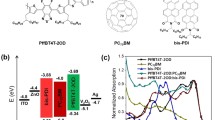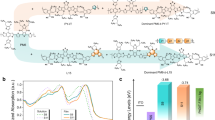Abstract
Fullerene derivatives have been ubiquitous as an electron-accepting material in organic photovoltaic solar cells (OSCs). We consider whether and why traces of PCBM oxidation products should be seen as electronic defects impairing the performance of OSCs. Thin PCBM deposits were first illuminated under ambient air for a few minutes, thus revealing the extraordinary easiness of oxidizing PCBM. The charge transfer in polymer:PCBMox bulk heterojunctions was then studied. As a result of a few minutes of PCBM photooxidation, the electron transfer from the polymer to two types of PCBMox species was shown to occur at the expense of the transfer to pristine PCBM. Such modifications to the molecular structure of PCBM and to the charge transfer at the nanoscale were finally correlated with a dramatic loss in the device’s photovoltaic performance at the macroscale. This study clearly indicates the need to integrate photooxidation-resistant electron-accepting materials into OSCs to extend their lifetime.






Similar content being viewed by others
References
M.A. Green, K. Emery, Y. Hishikawa, W. Warta, and E.D. Dunlop: Solar cell efficiency tables (version 48): Solar cell efficiency tables (version 48). Prog. Photovoltaics Res. Appl. 24, 905–913 (2016).
D. Baran, R.S. Ashraf, D.A. Hanifi, M. Abdelsamie, N. Gasparini, J.A. Röhr, S. Holliday, A. Wadsworth, S. Lockett, M. Neophytou, C.J.M. Emmott, J. Nelson, C.J. Brabec, A. Amassian, A. Salleo, T. Kirchartz, J.R. Durrant, and I. McCulloch: Reducing the efficiency–stability–cost gap of organic photovoltaics with highly efficient and stable small molecule acceptor ternary solar cells. Nat. Mater. 16, 363–369 (2017).
P. Cheng and X. Zhan: Stability of organic solar cells: Challenges and strategies. Chem. Soc. Rev. 45, 2544–2582 (2016).
N. Grossiord, J.M. Kroon, R. Andriessen, and P.W.M. Blom: Degradation mechanisms in organic photovoltaic devices. Org. Electron. 13, 432–456 (2012).
A. Rivaton, A. Tournebize, J. Gaume, P-O. Bussière, J-L. Gardette, and S. Therias: Photostability of organic materials used in polymer solar cells. Polym. Int. 63, 1335–1345 (2014).
J-L. Gardette, A. Colin, S. Trivis, S. German, and S. Therias: Impact of photooxidative degradation on the oxygen permeability of poly(ethyleneterephthalate). Polym. Degrad. Stab. 103, 35–41 (2014).
H.S. Silva, J. Cresson, A. Rivaton, D. Bégué, and R.C. Hiorns: Correlating geometry of multidimensional carbon allotropes molecules and stability. Org. Electron. 26, 395–399 (2015).
J.P. Bastos, E. Voroshazi, E. Fron, G. Brammertz, T. Vangerven, M. van der Auweraer, J. Poortmans, and D. Cheyns: Oxygen-induced degradation in C60-based organic solar cells: Relation between film properties and device performance. ACS Appl. Mater. Interfaces 8, 9798–9805 (2016).
Y. Matsuo, A. Ozu, N. Obata, N. Fukuda, H. Tanaka, and E. Nakamura: Deterioration of bulk heterojunction organic photovoltaic devices by a minute amount of oxidized fullerene. Chem. Commun. 48, 3878–3880 (2012).
A. Rivaton, M. Manceau, S. Chambon, J-L. Gardette, S. Guillerez, and N. Lemaître: Light-induced degradation of the active layer of polymer-based solar cells. Polym. Degrad. Stab. 95, 278–284 (2010).
A. Tournebize, P-O. Bussière, A. Rivaton, J-L. Gardette, H. Medlej, R.C. Hiorns, C. Dagron-Lartigau, F.C. Krebs, and K. Norrman: New insights into the mechanisms of photodegradation/stabilization of P3HT:PCBM active layers using poly(3-hexyl-d13-thiophene). Chem. Mater. 25, 4522–4528 (2013).
M. Manceau, A. Rivaton, and J.L. Gardette: Photochemical stability of materials for OPV. In Stability and Degradation of Organic and Polymer Solar Cells, F.C. Krebs, ed. (Wiley Interscience, Chichester, United Kingdom, 2012); pp. 71–108.
S. Karuthedath, T. Sauermann, H.J. Egelhaaf, R. Wannemacher, C.J. Brabec, and L. Lüer: The effect of oxygen induced degradation on charge carrier dynamics in P3HT:PCBM and Si-PCPDTBT:PCBM thin films and solar cells. J. Mater. Chem. A 3, 3399–3408 (2015).
A. Seemann, T. Sauermann, C. Lungenschmied, O. Armbruster, S. Bauer, H-J. Egelhaaf, and J. Hauch: Reversible and irreversible degradation of organic solar cell performance by oxygen. Sol. Energy 85, 1238–1249 (2011).
D.K. Susarova, N.P. Piven, A.V. Akkuratov, L.A. Frolova, M.S. Polinskaya, S.A. Ponomarenko, S.D. Babenko, and P.A. Troshin: ESR spectroscopy as a powerful tool for probing the quality of conjugated polymers designed for photovoltaic applications. Chem. Commun. 51, 2239–2241 (2015).
B. Pépin-Donat, C. Ottone, C. Lombard, A. Lefrançois, C. Morell, P. Reiss, and S. Sadki: Electron paramagnetic resonance tracing of electronic transfers in push–pull copolymers/PCBM or nanocrystal composites. J. Phys. Chem. B 118, 20647–20660 (2014).
A. Tournebize, A. Rivaton, J-L. Gardette, C. Lombard, B. Pépin-Donat, S. Beaupré, and M. Leclerc: How photoinduced crosslinking under operating conditions can reduce PCDTBT-based solar cell efficiency and then stabilize it. Adv. Energy Mater. 4, 1301530 (2014).
J. Niklas and O.G. Poluektov: Organic photovoltaics: Charge transfer processes in OPV materials as revealed by EPR spectroscop. Adv. Energy Mater. 7, 1602226 (2017).
M. Salvador, N. Gasparini, J.D. Perea, S.H. Paleti, A. Distler, L.N. Inasaridze, P.A. Troshin, L. Lüer, H.J. Egelhaaf, and C. Brabec: Suppressing photooxidation of conjugated polymers and their blends with fullerenes through nickel chelates. Energy Environ. Sci. 10, 2005–2016 (2017).
M.T. Dang, L. Hirsch, and G. Wantz: P3HT:PCBM, best seller in polymer photovoltaic research. Adv. Mater. 23, 3597–3602 (2011).
F. Neese: The ORCA program system. Wiley Interdiscip. Rev.: Comput. Mol. Sci. 2, 73–78 (2012).
A.K. Dutta, F. Neese, and R. Izsak: Speeding up equation of motion coupled cluster theory with the chain of spheres approximation. J. Chem. Phys. 144, 034102 (2016).
D. Ganyushin and F. Neese: A fully variational spin-orbit coupled complete active space selfconsistent field approach: Application to electron paramagnetic resonance g-tensors. J. Chem. Phys. 138, 104113 (2013).
B. Sandhoefer and F. Neese: One-electron contributions to the g-tensor for second-order Douglas–Kroll–Hess theory. J. Chem. Phys. 137, 094102 (2012).
A. Distler, T. Sauermann, H-J. Egelhaaf, S. Rodman, D. Waller, K-S. Cheon, M. Lee, and D.M. Guldi: The effect of PCBM dimerization on the performance of bulk heterojunction solar cells. Adv. Energy Mater. 4, 1300693 (2014).
A. Dzwilewski, T. Wågberg, and L. Edman: Photo-induced and resist-free imprint patterning of fullerene materials for use in functional electronics. J. Am. Chem. Soc. 131, 4006–4011 (2009).
T. Heumueller, W.R. Mateker, A. Distler, U.F. Fritze, R. Cheacharoen, W.H. Nguyen, M. Biele, M. Salvador, M. von Delius, H-J. Egelhaaf, M.D. McGehee, and C.J. Brabec: Morphological and electrical control of fullerene dimerization determines organic photovoltaic stability. Energy Environ. Sci. 9, 247–256 (2016).
P. Zhou, Z-H. Dong, A.M. Rao, and P.C. Eklund: Reaction mechanism for the photopolymerization of solid fullerene C60. Chem. Phys. Lett. 211, 337 (1993).
P.C. Eklund, A.M. Rao, P. Zhou, Y. Wang, and J.M. Holden: Photochemical transformation of C60 and C70 films. Thin Solid Films 257, 185–203 (1995).
S. Chambon, A. Rivaton, J-L. Gardette, and M. Firon: Photo- and thermal degradation of MDMO-PPV:PCBM blends. Sol. Energy Mater. Sol. Cells 91, 394–398 (2007).
M.O. Reese, A.M. Nardes, B.L. Rupert, R.E. Larsen, D.C. Olson, M.T. Lloyd, S.E. Shaheen, D.S. Ginley, G. Rumbles, and N. Kopidakis: Photoinduced degradation of polymer and polymer-fullerene active layers: Experiment and theory. Adv. Funct. Mater. 20, 3476–3483 (2010).
R. Taylor, M.P. Barrow, and T.A. Drewello: C60 degrades to C120O. Chem. Commun., 2497–2498 (1998).
P. Paul, R.D. Bolskar, A.M. Clark, and C.A. Reed: The origin of the ‘spike’ in the EPR spectrum of C60−. Chem. Commun., 1229–1230 (2000).
J. De Ceuster, E. Goovaerts, A. Bouwen, J.C. Hummelen, and V. Dyakonov: High-frequency (95 GHz) electron paramagnetic resonance study of the photoinduced charge transfer in conjugated polymer–fullerene composites. Phys. Rev. B 64, 195206 (2001).
J. Niklas, K.L. Mardis, B.P. Banks, G.M. Grooms, A. Sperlich, V. Dyakonov, S. Beaupre, M. Leclerc, T. Xu, L. Yu, and O.G. Poluektov: Highly-efficient charge separation and polaron delocalization in polymer–fullerene bulk-heterojunctions: A comparative multi-frequency EPR and DFT study. Phys. Chem. Chem. Phys. 15, 9562–9574 (2013).
O.G. Poluektov, S. Filippone, N. Martin, A. Sperlich, C. Deibel, and V. Dyakonov: Spin signatures of photogenerated radical anions in polymer–[70]fullerene bulk heterojunctions: High frequency pulsed EPR spectroscopy. J. Phys. Chem. B 114, 14426–14429 (2010).
K.L. Mardis, J.N. Webb, T. Holloway, J. Niklas, and O.G. Poluektov: Electronic structure of fullerene acceptors in organic bulk-heterojunctions: A combined EPR and DFT study. J. Phys. Chem. Lett. 6, 4730–4735 (2015).
A. Konkin, U. Ritter, P. Scharff, G. Mamin, A. Aganov, S. Orlinskii, V. Krinichnyi, D.A.M. Egbe, G. Ecke, and H. Romanus: Multifrequency X,W-band ESR study on photo-induced ion radical formation in solid films of mono- and di-fullerenes embedded in conjugated polymers. Carbon 77, 11–17 (2014).
C.A. Reed and R.D. Bolskar: Discrete fulleride anions and fullerenium cations. Chem. Rev. 100, 1075–1120 (2000).
P. Rapta, A. Bartl, A. Gomorov, A. Stasko, and L. Dunsch: In situ ESR/Vis/NIR spectroelectrochemistry of [60]fullerene: The origin of ESR “spikes” and the reactivity of pristine fullerene anions. ChemPhysChem 3, 351–355 (2002).
A. Sperlich, H. Kraus, C. Deibel, H. Blok, J. Schmidt, and V. Dyakonov: Reversible and irreversible interactions of poly(3-hexylthiophene) with oxygen studied by spin-sensitive methods. J. Phys. Chem. B 115, 13513–13518 (2011).
H. Santos Silva, I. Fraga Domínguez, A. Perthué, P.D. Topham, P-O. Bussière, R.C. Hiorns, C. Lombard, A. Rivaton, D. Bégué, and B. Pépin-Donat: Designing intrinsically photostable low band gap polymers: A smart tool combining EPR spectroscopy and DFT calculations. J. Mater. Chem. A 4, 15647–15654 (2016).
S. Chambon, L. Derue, M. Lahaye, B. Pavageau, L. Hirsch, and G. Wantz: MoO3 thickness, thermal annealing and solvent annealing effects on inverted and direct polymer photovoltaic solar cells. Materials 5, 2521–2536 (2012).
A.D. Becke: Density-functional thermochemistry. III. The role of exact exchange. J. Chem. Phys. 98, 5648–5652 (1993).
C. Lee, W. Yang, and R.G. Parr: Development of the Colle-Salvetti correlation-energy formula into a functional of the electron density. Phys. Rev. B 37, 785–789 (1988).
S.H. Vosko, L. Wilk, and M. Nusair: Accurate spin-dependent electron liquid correlation energies for local spin density calculations: A critical analysis. Can. J. Phys. 58, 1200–1211 (1980).
S. Grimme, S. Ehrlich, and L. Goerigk: Effect of the damping function in dispersion corrected density functional theory. J. Comput. Chem. 32, 1456–1465 (2011).
ACKNOWLEDGMENT
This work was supported by the Agence Nationale de la Recherche (ANR) through the PROGELEC 2013 program “HELIOS” (ANR-13-PRGE-0006).
Author information
Authors and Affiliations
Corresponding authors
Supporting Information
Rights and permissions
About this article
Cite this article
Perthué, A., Gorisse, T., Silva, H.S. et al. New insights into polymer solar cells stability: The crucial role of PCBM oxidation. Journal of Materials Research 33, 1868–1878 (2018). https://doi.org/10.1557/jmr.2018.141
Received:
Accepted:
Published:
Issue Date:
DOI: https://doi.org/10.1557/jmr.2018.141




